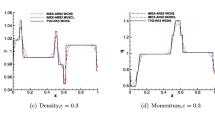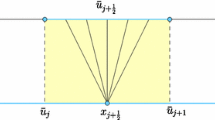Abstract
In this paper, the design and analysis of a class of second order accurate IMEX finite volume schemes for the compressible Euler equations in the zero Mach number limit is presented. In order to account for the fast and slow waves, the nonlinear fluxes in the Euler equations are split into stiff and non-stiff components, respectively. The time discretisation is performed by an IMEX Runge–Kutta method, therein the stiff terms are treated implicitly and the non-stiff terms explicitly. In the space discretisation, a Rusanov-type central flux is used for the non-stiff part, and simple central differencing for the stiff part. Both the time semi-discrete and space-time fully-discrete schemes are shown to be asymptotic preserving. The numerical experiments confirm that the schemes achieve uniform second order convergence with respect to the Mach number. A notion of accuracy at low Mach numbers, termed as the asymptotic accuracy, is introduced in terms of the invariance of a well-prepared space of constant densities and divergence-free velocities. The asymptotic accuracy is concerned with the closeness of the compressible solution with that of its incompressible counterpart in a low Mach number regime. It is shown theoretically as well as numerically that the proposed schemes are asymptotically accurate.






Similar content being viewed by others
References
Arun, K.R., Das Gupta, A.J., Samantaray, S.: An implicit–explicit scheme accurate at low Mach numbers for the wave equation system. In: Theory, Numerics and Applications of Hyperbolic Problems. I, vol. 236, Springer Proceedings in Mathematics & Statistics, pp. 97–109. Springer, Cham (2018)
Ascher, U.M., Ruuth, S.J., Spiteri, R.J.: Implicit-explicit Runge–Kutta methods for time-dependent partial differential equations. Appl. Numer. Math. 25(2–3), 151–167 (1997). Special issue on time integration (Amsterdam, 1996)
Audusse, E., Do, M.H., Omnes, P., Penel, Y.: Analysis of modified Godunov type schemes for the two-dimensional linear wave equation with Coriolis source term on cartesian meshes. J. Comput. Phys. 373, 91–129 (2018)
Benacchio, T., O’Neill, W.P., Klein, R.: A blended soundproof-to-compressible numerical model for small-to-mesoscale atmospheric dynamics. Mon. Weather Rev. 142(12), 4416–4438 (2014)
Bijl, H., Wesseling, P.: A unified method for computing incompressible and compressible flows in boundary-fitted coordinates. J. Comput. Phys. 141(2), 153–173 (1998)
Bispen, G., Arun, K.R., Lukáčová-Medvid’ová, M., Noelle, S.: IMEX large time step finite volume methods for low Froude number shallow water flows. Commun. Comput. Phys. 16(2), 307–347 (2014)
Bispen, G., Lukáčová-Medviďová, M., Yelash, L.: Asymptotic preserving IMEX finite volume schemes for low Mach number Euler equations with gravitation. J. Comput. Phys. 335, 222–248 (2017)
Boscarino, S.: Error analysis of IMEX Runge–Kutta methods derived from differential-algebraic systems. SIAM J. Numer. Anal. 45(4), 1600–1621 (2007)
Boscarino, S., Qiu, J.-M., Russo, G., Xiong, T.: A high order semi-implicit IMEX WENO scheme for the all-Mach isentropic Euler system. J. Comput. Phys. 392, 594–618 (2019)
Boscarino, S., Russo, G., Scandurra, L.: All Mach number second order semi-implicit scheme for the Euler equations of gas dynamics. J. Sci. Comput. 77(2), 850–884 (2018)
Cordier, F., Degond, P., Kumbaro, A.: An asymptotic-preserving all-speed scheme for the Euler and Navier–Stokes equations. J. Comput. Phys. 231(17), 5685–5704 (2012)
Degond, P.: Asymptotic-preserving schemes for fluid models of plasmas. In: Numerical Models for Fusion, vol. 39/40 of Panor. Synthèses, pp. 1–90. Soc. Math. France, Paris (2013)
Degond, P., Tang, M.: All speed scheme for the low Mach number limit of the isentropic Euler equations. Commun. Comput. Phys. 10(1), 1–31 (2011)
Dellacherie, S.: Analysis of Godunov type schemes applied to the compressible Euler system at low Mach number. J. Comput. Phys. 229(4), 978–1016 (2010)
Dellacherie, S., Omnes, P., Rieper, F.: The influence of cell geometry on the Godunov scheme applied to the linear wave equation. J. Comput. Phys. 229(14), 5315–5338 (2010)
Dimarco, G., Loubère, R., Michel-Dansac, V., Vignal, M.-H.: Second-order implicit–explicit total variation diminishing schemes for the Euler system in the low Mach regime. J. Comput. Phys. 372, 178–201 (2018)
Dimarco, G., Loubère, R., Vignal, M.-H.: Study of a new asymptotic preserving scheme for the Euler system in the low Mach number limit. SIAM J. Sci. Comput. 39(5), A2099–A2128 (2017)
Feistauer, M., Kučera, V.: On a robust discontinuous Galerkin technique for the solution of compressible flow. J. Comput. Phys. 224(1), 208–221 (2007)
Guillard, H., Viozat, C.: On the behaviour of upwind schemes in the low Mach number limit. Comput. Fluids 28(1), 63–86 (1999)
Haack, J., Jin, S., Liu, J.-G.: An all-speed asymptotic-preserving method for the isentropic Euler and Navier–Stokes equations. Commun. Comput. Phys. 12, 955–980 (2012)
Hairer, E., Wanner, G.: Solving Ordinary Differential Equations. II. Springer Series in Computational Mathematics, vol. 14, 2nd edn. Springer, Berlin (1996). Stiff and differential-algebraic problems
Jin, S.: Efficient asymptotic-preserving (AP) schemes for some multiscale kinetic equations. SIAM J. Sci. Comput. 21(2), 441–454 (1999)
Jin, S.: Asymptotic preserving (AP) schemes for multiscale kinetic and hyperbolic equations: a review. Riv. Math. Univ. Parma (N.S.) 3(2), 177–216 (2012)
Kennedy, C.A., Carpenter, M.H.: Additive Runge–Kutta schemes for convection–diffusion–reaction equations. Appl. Numer. Math. 44(1), 139–181 (2003)
Klainerman, S., Majda, A.: Singular limits of quasilinear hyperbolic systems with large parameters and the incompressible limit of compressible fluids. Commun. Pure Appl. Math. 34(4), 481–524 (1981)
Klainerman, S., Majda, A.: Compressible and incompressible fluids. Commun. Pure Appl. Math. 35(5), 629–651 (1982)
Klein, R.: Semi-implicit extension of a Godunov-type scheme based on low Mach number asymptotics. I. One-dimensional flow. J. Comput. Phys. 121(2), 213–237 (1995)
Klein, R., Botta, N., Schneider, T., Munz, C.D., Roller, S., Meister, A., Hoffmann, L., Sonar, T.: Asymptotic adaptive methods for multi-scale problems in fluid mechanics. J. Engrg. Math. 39(1–4), 261–343 (2001). Special issue on practical asymptotics
Meister, A.: Asymptotic single and multiple scale expansions in the low Mach number limit. SIAM J. Appl. Math. 60(1), 256–271 (2000). (electronic)
Munz, C.-D., Roller, S., Klein, R., Geratz, K.J.: The extension of incompressible flow solvers to the weakly compressible regime. Comput Fluids 32(2), 173–196 (2003)
Noelle, S., Bispen, G., Arun, K.R., Lukáčová-Medviďová, M., Munz, C.-D.: A weakly asymptotic preserving low Mach number scheme for the Euler equations of gas dynamics. SIAM J. Sci. Comput. 36(6), B989–B1024 (2014)
Pareschi, L., Russo, G.: Implicit–explicit Runge–Kutta schemes for stiff systems of differential equations. In: Recent Trends in Numerical Analysis, volume 3 of Adv. Theory Comput. Math., pp. 269–288. Nova Sci. Publ., Huntington, NY (2001)
Pareschi, L., Russo, G.: Implicit–explicit Runge–Kutta schemes and applications to hyperbolic systems with relaxation. J. Sci. Comput. 25(1–2), 129–155 (2005)
Schneider, T., Botta, N., Geratz, K.J., Klein, R.: Extension of finite volume compressible flow solvers to multi-dimensional, variable density zero Mach number flows. J. Comput. Phys. 155(2), 248–286 (1999)
Schochet, S.: Fast singular limits of hyperbolic PDEs. J. Differ. Equ. 114(2), 476–512 (1994)
Smolarkiewicz, P.K., Kühnlein, C., Wedi, N.P.: A consistent framework for discrete integrations of soundproof and compressible PDEs of atmospheric dynamics. J. Comput. Phys. 263, 185–205 (2014)
Tang, M.: Second order all speed method for the isentropic Euler equations. Kinet. Relat. Models 5(1), 155–184 (2012)
Zakerzadeh, H., Noelle, S.: A note on the stability of implicit–explicit flux-splittings for stiff systems of hyperbolic conservation laws. Commun. Math. Sci. 16(1), 1–15 (2018)
Acknowledgements
The authors thank the anonymous referees whose comments have lead to a significant improvement of the manuscript.
Author information
Authors and Affiliations
Corresponding author
Additional information
Publisher's Note
Springer Nature remains neutral with regard to jurisdictional claims in published maps and institutional affiliations.
Appendix
Appendix
First, let us introduce the following shorthands (see Fig. 7 for RK coefficients).
With the above notations, the entries in the matrices \(\mathcal {B}^{(2)},B^{(3)}\) and \(B^{(4)}\) read
Rights and permissions
About this article
Cite this article
Arun, K.R., Samantaray, S. Asymptotic Preserving Low Mach Number Accurate IMEX Finite Volume Schemes for the Isentropic Euler Equations. J Sci Comput 82, 35 (2020). https://doi.org/10.1007/s10915-020-01138-8
Received:
Revised:
Accepted:
Published:
DOI: https://doi.org/10.1007/s10915-020-01138-8
Keywords
- Compressible Euler system
- Incompressible Euler system
- Zero Mach number limit
- IMEX-RK schemes
- Asymptotic preserving
- Asymptotic accuracy
- Finite volume method





